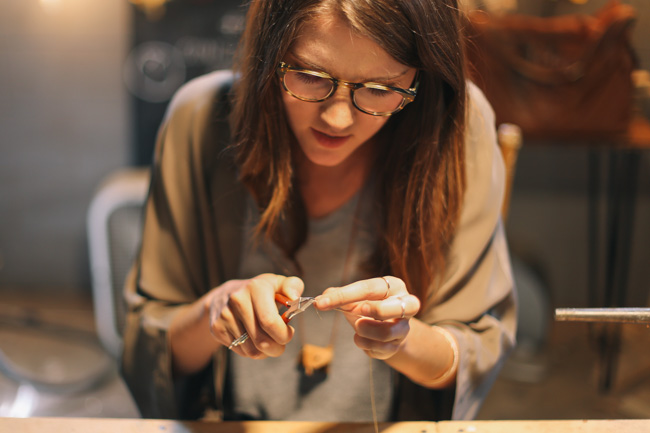The Steps
1st step - Autolize: In a large bowl, combine your starter, both types of flour and water. Using your hands is the best way to make sure the ingredients are evenly combined. Cover the bowl with a tea towel and leave to rest for at least 15 minutes and up to an hour.
2nd step - Salt + Knead: Add the salt to the dough and knead in the bowl for three minutes - folding, pushing, twisting and punching all work great. A handy tip is to keep a bowl of water close by to dip your hands into to prevent them sticking to the dough. Be careful though not to add too much excess water to the mixture - you don't want to unbalance the bread math ratio!
3rd step - Stretching: Cover the dough and allow to sit on the bench at room temperature for 45 minutes. After 45 minutes has passed, it's time to stretch the dough. Using your hands (dipped in water to prevent sticking), grab an edge of the dough and lift it up, allowing it to stretch. Fold it over itself so that it lays flat ontop of the dough. Turn the bowl a quarter turn and repeat. Do this two more times - four times in total. The stretching helps to encourage the formation of gluten that was initially formed from kneading the dough. Cover the bowl again and leave to rest for another 45 minutes.
After the 45 minutes rest, repeat the stretching step again. Cover and let rest for a further 45 minutes.
4th step - Shaping: For the initial shape, lightly flour a section of your workbench/counter top. Turn the dough out onto the bench so that the smoothest side is facing down. Take one end of the dough and stretch and fold over itself. Take the opposite end and do the same. This is creating tension on the opposite side of the dough which will become the top of the loaf of bread. Turn the dough over so that the top, smooth side is facing up. Here comes the tricky part to explain. You are now going to push the dough to create firm, smooth tension across the top. You may need to move the dough to an area of the bench that isn't as heavily floured so that it can grab the bench as you push it. The aim is to get a smooth tight surface on the top of the dough. Keep tucking the edges under to help with the tension, and keep sliding the dough carefully along the bench to create a round, smooth surface. Be careful not to go too far with the tension, you don't want any areas of the dough to tear. If you do get tears, try to tuck that area of the dough under, and push/slide the dough to reform a smooth surface. Your dough should end up in a rounded but flattish ball. Remember to use water on your hands to prevent them from sticking to the dough! Once you have a nice smooth and tight surface on the dough, allow it to sit on a floured area of the bench to rest for 20 minutes.
Once the dough has rested for 20 minutes, it's time for the final shaping. Turn the smooth side down onto the bench again. Repeat the same steps as above, starting with the stretching/folding, and ending with the pushing. This time however, you want to shape the dough into the same shape as you intend your final loaf to be depending on the bread basket or loaf pan that you have. The traditional shapes of Sourdough tend to be either oblong, round or baguette. I have an oblong bread basket, but I also like to use a round bowl to change the shape of my loaves up a bit.
If you have a bread basket, generously dust/coat it with rice flour. If you have a loaf pan or bowl, first spray/brush with oil, then generously coat with rice flour. Once your basket or bowl has been coated, gently place your dough, smooth side down, into the basket or bowl. Cover with a tea towel.
5th step - Proofing: You have two choices with proofing. You can allow the bread to proof for 2 hours at room temperature on the bench top if you would like to bake it the same day OR you can place the bread at room temperature on the bench for 3o minutes, then place in the fridge for 12 hours, so that it is ready to bake the next day.
6th step - Baking: Traditionally, sourdough is baked at a very high temperature in a hearth oven that is made or lined with stone to retain the heat. To replicate this at home, you will need a baking stone (I've been using a pizza stone but I've been told that using a saltillo stone bought from home depot/bunnings can also do the trick). The baking stone is important to retain the high heat of the oven which will allow even, consistent baking of the bread. It also helps to pull moisture from the dough to create a lovely, crackly crust - the type that is found on beautiful sourdough loaves.
Preheat your oven and stone to 500 °F / 260 °C for at least half an hour.
Dust your peel/breadboard with handle with cornflour or corn meal. I also like to throw on a bit of rice flour for good measure - beautiful bread dough sticking to your peel as you go to put it in the oven makes it not so beautiful. Using your fingers, delicately go around the loaf to be sure that it hasn't stuck to the basket or bowl. Turn it out onto your floured peel.
It's time now to slash. This part can be tricky - I'm still yet to master. The idea of slashing or scoring your bread is to control the area of bread that you would most like it to expand during baking. This will create those lovely patterns that you see on top of artisan bread loaves. To slash, you will need either a very sharp finely serrated knife, or a razor blade. The slashing needs to be swift, confident and delicate as not to press down on and deflate the dough. It's a good idea to begin with a simple slash - one straight slash down the middle is a good start. Of course, you can get as creative as you like, the more confident you get.
Here are some tips and instructions that I found from another helpful site - weekendbakery.com (take a peek to see what it's all about):
- Make swift and confident slashes, but at the same time be gentle (iron hand in velvet glove).
- Let the knife do the work. Don’t press down on the dough.
- Wet the blade in water between slices (especially when working with sticky dough).
- If you want to create an “ear,” the knife blade should be held at a shallow angle (about 30 degrees) with the surface of the loaf, about 0.6 cm/ ¼ inch deep.
- Practise, practise, practise, bake, bake , bake, score, score score!
Baking times:
What I was told at the workshop : slide the bread onto your baking stone and bake in the oven at 500 °F / 260 °C for the first 10-15 minutes, then turn the oven down to 420 °F / 215°C for a further 30-35 minutes (45 minutes in total)
What I found using my oven: bake in the oven at 550 °F / 287 °C for 10 minutes, then turn oven down to 420 °F / 215°C for 40 minutes. A little variation from the above method, but I found that my bread wasn't cooking through, so I decided to try baking the bread at a hotter temp and for a longer total time and it worked great! Every oven is different. You will find the best timings for your oven through trial and error.
You should be able to tell if the bread is done by turning it over and hearing a hollow sound when you tap it. Bread not cooked? Put it back in for longer!





























































